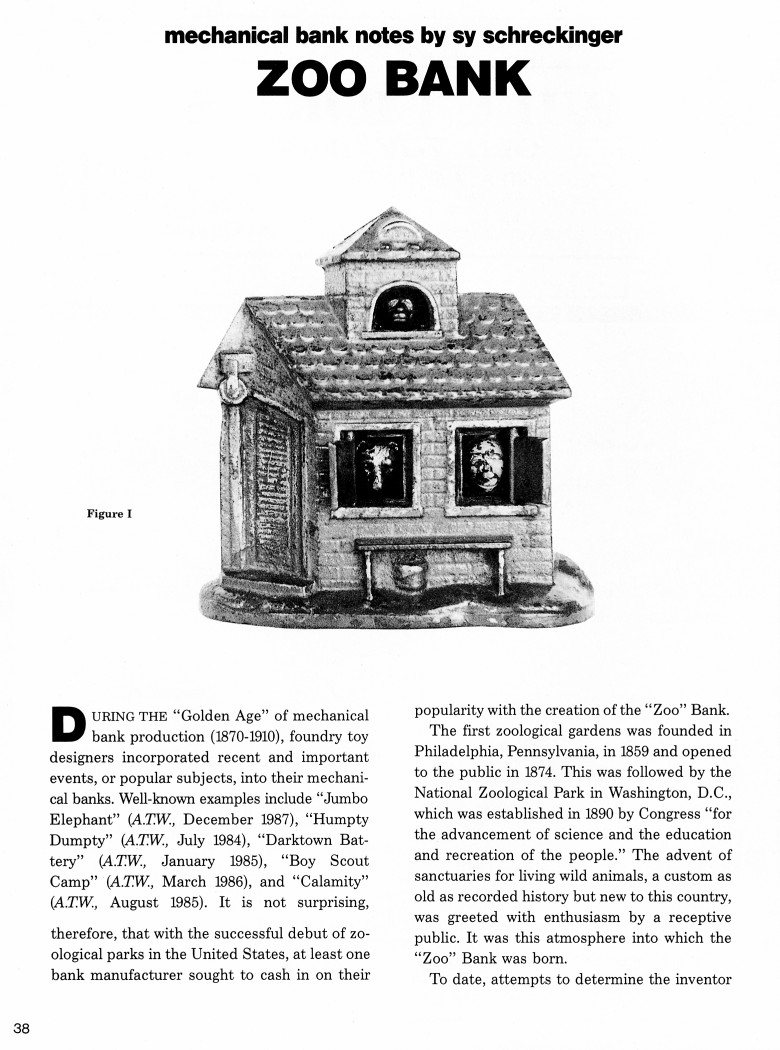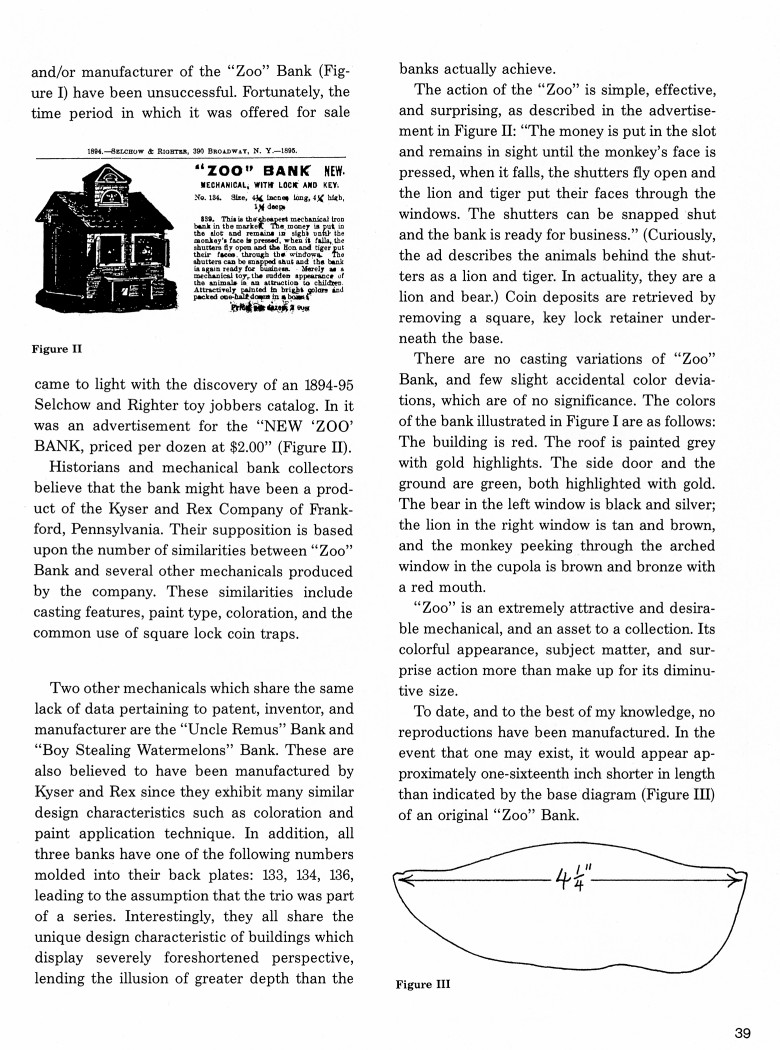|
Zoo Bank
by Sy Schreckinger – ANTIQUE TOY WORLD Magazine – June, 1992
During the "Golden Age" of mechanical bank
production (1870-1910), foundry toy designers incorporated recent and
important events, or popular subjects, into their mechanical banks.
Well-known examples include "Jumbo Elephant" (A.T.W.,
December 1987),
"Humpty Dumpty" (A.T.W.,
July 1984), "Darktown Battery" (A.T.W.,
January
1985), "Boy Scout Camp" (A.T.W.,
March 1986), and "Calamity" (A.T.W.,
August
1985). It is not surprising, therefore, that with the successful debut of
zoological parks in the United States, at least one bank manufacturer
sought to cash in on their popularity with the creation of the "Zoo" Bank.
The first zoological gardens was founded in Philadelphia,
Pennsylvania, in 1859 and opened to the public in 1874. This was followed
by the National Zoological Park in Washington, D.C., which was established
in 1890 by Congress "for the advancement of science and the education and
recreation of the people." The advent of sanctuaries for living wild
animals, a custom as old as recorded history but new to this country, was
greeted with enthusiasm by a receptive public. It was this atmosphere into
which the "Zoo" Bank was born.
To date, attempts to determine the inventor and/or manufacturer of
the "Zoo" Bank (Figure I) have been unsuccessful. Fortunately, the time
period in which it was offered for sale came to light with the discovery
of an 1894-95 Selchow and Righter toy jobbers catalog. In it was an
advertisement for the "NEW 'ZOO' BANK, priced per dozen at $2.00" (Figure
II).
Historians and mechanical bank collectors believe that the bank might
have been a product of the Kyser and Rex Company of Frankford,
Pennsylvania. Their supposition is based upon the number of similarities
between "Zoo" Bank and several other mechanicals produced by the company.
These similarities include casting features, paint type, coloration, and
the common use of square lock coin traps.
Two other mechanicals which share the same lack of data pertaining to
patent, inventor, and manufacturer are the "Uncle Remus" Bank and "Boy
Stealing Watermelons" Bank. These are also believed to have been
manufactured by Kyser and Rex since they exhibit many similar design
characteristics such as coloration and paint application technique. In
addition, all three banks have one of the following numbers molded into
their back plates: 133, 134, 136, leading to the assumption that the trio
was part of a series. Interestingly, they all share the unique design
characteristic of buildings which display severely foreshortened
perspective, lending the illusion of greater depth than the banks actually
achieve.
The action of the "Zoo" is simple, effective, and surprising, as
described in the advertisement in Figure II: "The money is put in the slot
and remains in sight until the monkey's face is pressed, when it falls,
the shutters fly open and the lion and tiger put their faces through the
windows. The shutters can be snapped shut and the bank is ready for
business." (Curiously, the ad describes the animals behind the shutters as
a lion and tiger. In actuality, they are a lion and bear.) Coin deposits
are retrieved by removing a square, key lock retainer underneath the
base.
There are no casting variations of "Zoo" Bank, and few slight
accidental color deviations, which are of no significance. The colors of
the bank illustrated in Figure I are as follows: The building is red. The
roof is painted grey with gold highlights. The side door and the ground
are green, both highlighted with gold. The bear in the left window is
black and silver; the lion in the right window is tan and brown, and the
monkey peeking through the arched window in the cupola is brown and bronze
with a red mouth.
"Zoo" is an extremely attractive and desirable mechanical, and an
asset to a collection. Its colorful appearance, subject matter, and
surprise action more than make up for its diminutive size.
To date, and to the best of my knowledge, no reproductions have been
manufactured. In the event that one may exist, it would appear
approximately one-sixteenth inch shorter in length than indicated by the
base diagram (Figure III) of an original "Zoo" Bank.
|


